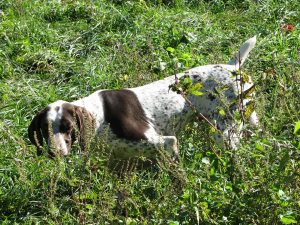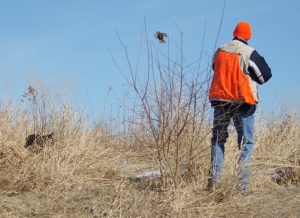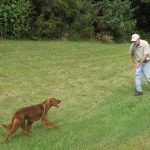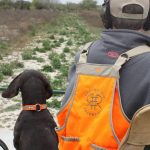First Season Series– Challenges : The Dog that Quits Hunting
Pointing Dog Pointer
by Bob and Jody Iler, Green Valley Kennels
As your pup’s first hunting season draws to a close, some challenges may have popped up—these issues are normal and give us the chance to “nip them in the bud” before they become major problems.
The young dog that quits hunting can cause a new pointing dog owner major concern. You may notice that your pup has begun to lose enthusiasm in the field, but you aren’t sure why. You might wonder if something happened that you aren’t aware of to cause this behavior. Or maybe you do recall the day when pup quit hunting and you have a good idea why.
There’s more than a few scenarios that can cause this issue. We’ll share a few examples of dogs we’ve trained that experienced this “challenge” in the first season.
Bad Weather Conditions
On a late season pheasant hunt in South Dakota, we had brought two of our seasoned dogs and a young started dog, Bud, with lots of natural ability. There was quite a bit of snow and weather conditions were cold and windy at times.
The first hunt went well for Bud, but the next day out, we hunted an area where the snow was knee deep in spots. He quickly lost interest in trying to hunt in the difficult conditions and began following behind us in the trail we broke walking through the snow. We picked Bud up that day and didn’t put him down again for a hunt during the remainder of our three-day trip. Getting him out again would have only reinforced an unpleasant experience and that’s something we never want to do.
Once we got Bud home, we worked him in easy cover and better weather conditions and made sure he found some of our training birds to rev up his enthusiasm. That way, we ensured that he ended his first season imprinted with a good experience. Young dogs that haven’t yet developed that “eye of the tiger” will lose enthusiasm quickly in bad weather and tough cover conditions.
Pup Doesn’t See the Bird, Too Many Shots
Sophie, a young German Shorthair, was brought to our kennel because her owner said she had quit hunting. She’d been out one day in her first season eagerly checking out some switch grass alongside some picked corn. Her owner was hunting with a couple buddies who were walking through the corn, a distance away, and flushed and shot a pheasant (with several shots) that Sophie hadn’t scented, pointed, worked or seen.
Immediately Sophie stopped hunting and returned to her owner’s side, refusing to get out and hunt again. Occasionally young dogs with little hunting experience will become upset with gunfire if they are not focused on the bird or have had inadequate development to the gun.
With Sophie, we got her out on quail, with no gun work at all, until she was hunting with enthusiasm and having fun again. Slowly, we reintroduced the gun to the process, making sure she was focused on the bird and chasing it when we shot. The lesson here: make sure the young dog is working the bird and sees the bird that is shot. Also, keep the number of hunting companions and shooting to a minimum until you have a seasoned dog.
Bird Shy
Jake was seven months old when his owner brought him to us, saying that he seemed afraid of pheasants. When a pheasant flushed, Jake would run the other way instead of chasing after it. Now, he was even reluctant to move away from his owner’s side when he went out to the field.
We put Jake back into our beginner program, getting him out on the smaller, gamey quail after gently introducing him to them and their scent. With the quail, there was no loud cackling and whoosh of feathers to scare the pup, and it wasn’t long before Jake was turned on to quail, big time! As our sessions progressed, we used chukar partridge, and finally, we put pheasants back in the mix, using only hens initially, which don’t cackle loudly or have spurs that could hurt a pup.
Remember: start small! Many young dogs need gradual bird introduction to awaken their bird-crazy genetics without scaring them off with too much, too soon.
Too Much Pressure
Jewel was brought to us in the beginning of her first season because she would do nothing but stand in the field when her owner took her out. He was a friendly, smart man who loved his pointing dog dearly. In fact, he cared about her so much that he bought and tried just about every training gizmo and method that he read about. Though his intentions were well-meaning, poor Jewel was overwhelmed with all the different things he had tried to teach her, before she was ready.
In particular, without much knowledge, training, or the help of a professional, he had tried to steady Jewel to wing and shot using an e-collar. This young dog hadn’t even had the benefit of a fun, first season where she could build enthusiasm and learn about hunting. Her owner had tried to put pressure on her way too soon in her development. This had resulted in a pup that was so afraid of what to do, or not to do, that she did not do anything at all.
Jewel, too, went back to the very basic beginnings of training, which were to let her have her head, find birds, and have lots and lots of fun. We encouraged Jewel to chase the birds and we put absolutely no control or pressure on her. Instead, we praised her for “breaking the rules” and helped fan the fire back into her. She came out of her shell because she was young and her owner had had the good sense to realize he needed some help to undo what he had done.
Jewel’s owner took her home with a heartfelt promise to keep things simple and fun – two very important ingredients in a successful first season!
Young Dogs Must Find Birds!
Finally, we have the fellow who called us to complain that his dog did not have a good nose and just couldn’t find birds. Worse yet, the pup did not even seem to want to hunt, he said. Since we were familiar with his pup’s bloodlines, we were surprised and a little bit skeptical about the pup’s “poor nose.”
He came with the pup to our kennel to show us the problem. Using spooky-planted quail in a 15-acre field, with a good idea of their whereabouts, we took the pup out. Long story short, pup did a superb job of finding the birds.
After some discussion with the pup’s owner, we found that he’d been hunting his pup for long stretches in areas with poor cover and little to no bird populations. Hunting young, inexperienced pups for long, unproductive periods is a sure way to cause them to lose interest. Especially in this first season, your pup should find birds.
We suggested that this fellow take his pup to the game preserve, where he could ensure that birds would be found, providing his pup with positive experiences. He followed our advice, and called us later, happy as a lark—saying that he knew all along that his pup had a “good nose!”
Your pup’s first season provides an evaluation time for both of you. You may not have had any issues crop up, but if you did, we hope we’ve helped you address some of them. With love and patience, there’s no “first season problem” too big to be fixed!
Pointing Dog Pointers features monthly training tips by Bob and Jody Iler, who own Green Valley Kennels in Dubuque, Iowa. Bob and Jody have trained pointing dogs for over 35 years and have written many articles for The Pointing Dog Journal.







